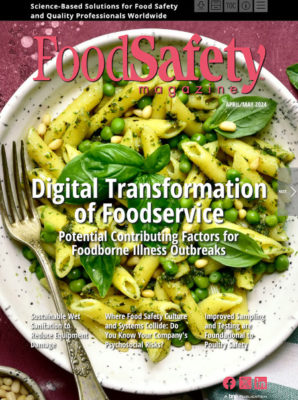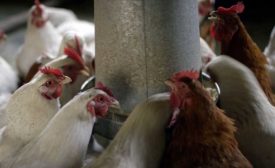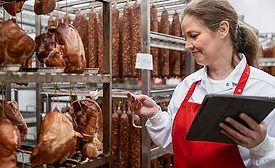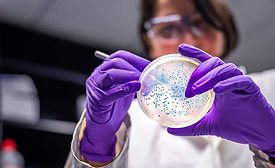Home » Publications » Food Safety Magazine
Our Publications
Please select a publication below.
Food Safety Magazine

April/May 2024
Cover Story
Back to TopThe integration of technology to meet higher demands on the foodservice business due to the large number of digital orders also offers significant opportunities to enhance food safety
Read More
Features
Back to TopImproved Sampling and Testing are Foundational to Poultry Safety
To what extent does poultry contribute to cases of salmonellosis, both directly and indirectly, and is there more the industry can do to protect public health?
April 9, 2024
Sustainable Wet Sanitation to Reduce Equipment Damage
Success can be achieved by working together to reimagine wet sanitation processes that clean effectively and efficiently while preserving assets and improving sustainability outcomes
April 9, 2024
Where Food Safety Systems and Culture Collide: Do You Know Your Company's Psychosocial Risks?
Psychosocial risks become important to food safety when they have the potential for causing psychological or physical harm, and when they lead to deficiencies in expected food safety behaviors
April 9, 2024
Columns
Back to TopControlled Environment Agriculture: A Systematic Review
The intensification of indoor agricultural systems must be achieved by specific processes that minimize negative impacts on the environment and place food safety front and center
April 10, 2024
Medically Important Foodborne Parasites: A Consequential Challenge for Food Safety Assurance
Foodborne parasitic diseases are often overlooked in food safety control schemes, even though they are known to pose a severe threat to human health
April 11, 2024
Applying Industry 4.0 to Food Safety
The opportunities for strengthening food safety through the adoption of Industry 4.0 technologies across the food supply chain are vast
April 11, 2024
Development and Application of AI for Food Processing and Safety Regulations
AI technologies have potential to revolutionize the food industry and the way USDA-FSIS employees inspect and ensure the safety of meat, poultry, RTE, NRTE, egg, and thermally processed products
April 10, 2024
California Tightens Requirements for Labeling Products as 'Compostable'
A number of challenges need to be addressed for compostable packaging to meet its potential
April 11, 2024
Review and Update of Methods for Metals Analysis in Foods
Metals detection at low concentration in food can be challenging from an analytical perspective and requires suitable guidance in terms of the instrumentation used and methodological approaches
Eve Kroukamp Ph.D.
Christopher J. Smith Ph.D.
Kevin Kubachka Ph.D.
Stéphane Dubascoux Ph.D.
Erik Konings Ph.D.
April 12, 2024
PFAS Litigation and FDA Updates for the Food Industry
Managing PFAS litigation risk requires food manufacturers and suppliers to take adequate steps to assess their exposure and allocate responsibility
April 12, 2024
Fundamentals of Conducting an Allergen Gap Assessment
Conducting an allergen gap assessment is one way to ensure regulatory compliance and consumer safety
April 15, 2024
Rapid Testing Methods—The Future
Most companies no longer have a microbiology lab or pathogen analysis capabilities, which will change the types of rapid test methods that will be in demand in the future
April 12, 2024
The Art of Bacterial Warfare: Know Thy Enemy
A new European project investigates the antibiotic resistance microbiome in oyster culture regions and seeks to unravel how antibiotic resistance genes move in the surrounding habitats
April 15, 2024
Malevolent AI: Navigating the Shadows of Technology Advancement in the Food Industry
AI's integration into the food industry has been largely beneficial, streamlining processes from production to distribution; however, this integration also opens doors for malevolent use
April 10, 2024
Never miss the latest news and trends driving the food safety industry
eNewsletter | Website | eMagazine
JOIN TODAY!Copyright ©2024. All Rights Reserved BNP Media.
Design, CMS, Hosting & Web Development :: ePublishing














